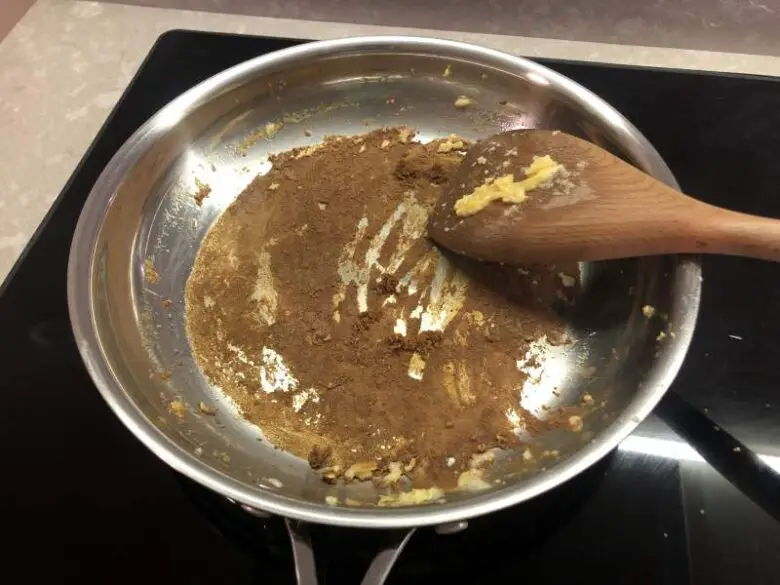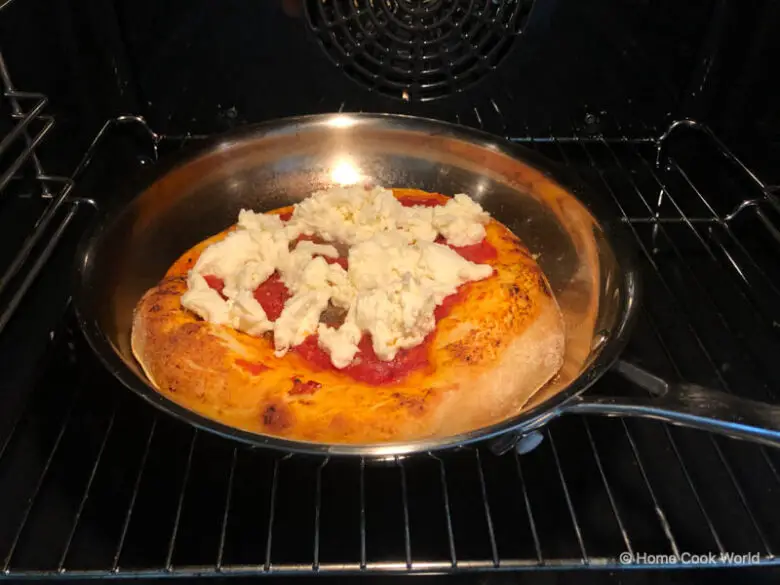Thinking of upgrading your cookware? Since you’re here, I’m going to bet that stainless steel is somewhere on top of your list.
Stainless steel frying pans are not cheap to buy and, to keep food from sticking, you need to know a thing or two about how to use them. But buy a good one and use it well, and you’ll be able to take your home cooking to the next level.
Trust me, I’m telling you this out of experience. I used to cook all of my food in non-stick pans. Until I grew tired of replacing them every 1-2 years because the coating would wear off. I then “graduated” to cast iron skillets which I still swear by, but not for all foods.
Some time ago, I began buying high-quality stainless steel cookware. Now, I do most of my cooking in American and Dutch pans and pots.
What are frying pans made of stainless steel good (and not that good) for?
Stainless steel frying pans are ideal for searing meat, poultry, and seafood; sautéeing mushrooms, asparagus, and other vegetables; cooking highly-acidic foods like tomatoes, vinegar, and wine; and making pan sauces.
As you can see, the cooking methods above involve either browning food at higher heat, such as searing and sauteing, or cooking it in plenty of liquid, as is the case with canned tomatoes and pan sauces.
The shiny, silver surface of stainless steel makes it easy for you to see when meats and vegetables are well browned, as well as when your pan sauces are ready.
But the uses for stainless steel don’t really end there.
Here’s a complete list of meals that you can make with a stainless steel frying pan—and the cooking methods, appliances, and temperatures to make them.
| Cooking Method | Cooking Appliance | Cooking Temperature | Example Dishes |
|---|---|---|---|
| Searing | On the stove | High heat | Steak, pork chops, meatballs |
| Broiling | In the oven | High heat | Tender beef cuts, pork chops, ground meat patties, whole birds or bird parts, kebab, fatty fish |
| Sautéing | On the stove | Medium-high heat | Mushrooms, asparagus, artichokes, bell peppers, chicken breasts, fish fillets, scallops |
| Deglazing | On the stove | Medium-high heat | Pan sauces, gravies, preparing a braise |
| Pan-frying | On the stove | Medium heat | Red meat, poultry, fish, vegetables |
| Baking | In the oven | Medium heat | Frittata, pizza, cornbread, meat pie, cheesecake, cherry pie |
Does Food Stick to Stainless Steel?
Food-grade stainless steel is made of an alloy that consists of iron, carbon, nickel, and chromium. The iron and carbon give your pan toughness; the nickel and chromium protect it from corrosion and rust.
The cooking surface of stainless steel pans is made of bare metal. Unlike their non-stick counterparts, there’s no ceramic or non-stick coating to keep food from sticking to it.
Foods high in protein and low in fat have the tendency to stick to stainless steel. Unless you use enough cooking fat or oil, such as extra virgin olive oil, or add plenty of cooking liquid, such as water, broth, beer, wine, or heavy spirit.
Stickier foods, like eggs, cod, hake, and scallops, can be difficult to cook without sticking in a stainless steel pan. If they make up most of your diet, you’re better-off buying non-stick cookware.
Salmon and other fatty fish like herring and anchovies are the exception, since some of the fat will melt and drip down into your pan, which will prevent them from sticking to the surface.
I’m not kidding about the eggs. Just take a look at what kept happening to my pan before I learned how to cook eggs in stainless steel:

Luckily for me, cleaning burnt eggs off my frying pan turned out to be easier than I anticipated.
How to Cook With Stainless Steel
You can cook 90% of your food in stainless steel without it sticking to the surface. So here’s what you need to do to make perfectly-browned meats and vegetables every single time you fire up the stove.
Food sticks to your stainless steel frying pan because it’s either too cold or too hot. You can keep that from happening by preheating your pan for 5 minutes, cooking with enough fat or oil, and getting your ingredients as close to room temperature as possible.
There are two scientific reasons why this trick works so well.
Stainless steel looks smooth and shiny to the naked eye. But look at it under a microscope and you’ll get a different picture: it’s actually covered with tiny holes and miniature cracks.
Metal expands and contracts as it heats up and cools down due to temperature changes. As the imperfections on the cooking surface of your frying pan grow and shrink, bits and pieces of food can easily get stuck in them.
When protein-rich foods come into contract with your pan’s cooking surface, they form chemical bonds with the metal atoms in it. The best and simplest way to counter this reaction is to add cooking oil or fat to your pan, giving it enough time to get hot.
You know that the cooking oil in your pan is hot enough when it starts to move around energetically in it. Telling when butter is hot enough is a little tricker.
Are Stainless Steel Frying Pans Any Good?
Some of the best cookware on the market is made from stainless steel.
There’s a good reason why professional chefs and seasoned home cooks alike use stainless steel cookware in their kitchens.
Stainless steel pans and pots are sturdy, functional, and long-lasting, which is why they’re a great choice for your daily cooking. You can cook with them on your stove or bake with them in the oven (typically at temperatures of up to 500°F). They’re dishwasher safe and can tolerate the occasional scratch from a metal utensil or scrub pad.
Unlike their non-stick counterparts, stainless steel frying pans have no ceramic or PTFE coating to worry about. Differently from cast iron skillets, which leach metal into acidic foods, you can cook tomato, vinegar, and wine-based sauces in them, even with long simmering times.
One major drawback of stainless steel is that food sticks to (and burns on) its surface. This is especially true for foods high in protein and low in fat, such as poultry, seafood, and eggs.
Then again, pouring ½ cup of cooking liquid (like beer or broth) in the pan while it’s still hot will dissolve the burnt-on food and produce the most wonderful pan sauces. With the right deglazing technique, you can actually use this drawback to your advantage.
Anyone who’s tried frying eggs or making an omelette in a stainless steel frying pan for the first time will know what I’m talking about. It will take you time and good ol’ trial and error to learn how to use your pan without causing most foods to stick to it.
The jury’s out when it comes to the safety of cooking with stainless steel.
Stainless steel cookware is made from food-grade stainless steel. It’s considered safe for food contact by the US Food & Drug Administration (FDA), the American National Standards Institute (ANSI), as well as the US National Science Foundation (NSF).
A study in the October 2013 issue of the Journal of Agricultural & Food Chemistry found that stainless steel cookware can be “an overlooked source of nickel and chromium” in its owners’ diets. Generally speaking, the lower-quality the pan, the bigger the amount leached.
Ultimately, it’s your home kitchen and your choice of cookware. I cook with stainless steel and cast iron. I avoid using non-stick skillets, ceramic- and PTFE-coated, since they’re too capricious and their coating wears out too easy, too fast when used daily.
Are Stainless Steel Pans Oven-Safe?

For the most part, stainless steel pans are oven safe (unless the manufacturer of a given make and model has explicitly stated otherwise).
Typically, stainless steel frying pans are safe to use in the oven at temperatures of up to 500°F (260°C). Some higher-quality pans with a thick and heavy base can be heated to as much as 600°F (315°C).
Stainless steel cookware pieces with metal handles are more functional than those with handles made of plastic, silicone, or wooden. Metal handles are much harder to get damaged in your oven.
If you plan to use your stainless steel pan in the oven, choose one with a metal handle. The handle gets scorching hot and you’ll need to hold it with an oven mitt or kitchen towel.
Still, that’s a small price to pay for the versatility that you get in return. Plastic, silicone, and wooden handles can easily get damaged from the hot air circulating in your oven.
What to Look for In a Stainless Steel Frying Pan
The metal that a frying pan is made of is important, but its thickness matters even more. A thick base allows the pan to heat up quickly and evenly when cooking, and makes it less likely to warp when exposed to thermal shock.
When shopping for stainless steel cookware, go for the pans and pots with a moderately heavy base.
There are two types of stainless steel frying pans on the market: (1) those made of 100% stainless steel and (2) those made of stainless steel clad around another metal.
“Cladding” is the process of making metallic cookware by layering two or more sheets of metal together and bonding them into a single piece.
Clad cookware is typically made of a stainless steel exterior wrapped around an aluminum or copper core. When choosing clad cookware, you should pay attention to two things:
- The number of layers the pan is made from
- The metal that the core of the pan is made from (aluminum or copper)
In general, the more layers of metal a pan is made of, the higher-quality it is.
Clad pans made of two metal layers are called “two-ply,” those made of three “tri-ply,” five are “five-ply,” and seven are “seven-ply”. Two-ply cookware is a little thin, three-ply and five-play sell at a good price, and seven-ply are the expensive pans and pots that only chefs use.
I’ve noticed that the price difference between same-sized three-ply and five-ply pans from the same manufacturer is often not that much, especially when you consider that you buy cookware like this once or twice in your lifetime.
Pans with a copper core heat up quickly and react the fastest when you turn the heat on your cooktop up or down, giving you the best control over cooking temperature. Compared to pans with an aluminum core, they’re also significantly more expensive.
Pans with an aluminum core are almost as responsive to heat changes as the ones with a core made of copper—and considerably cheaper. It’s highly unlikely that you’ll notice that difference as a home cook, which is why they’re the better option for your daily cooking.
As a whole, stainless steel pans clad around an aluminum or copper core will outperform most pans made from 100% steel. Tri-ply and five-ply pans will give you the best value for the money.
What’s your experience with buying stainless steel cookware? Share your tips, tricks, and stories in the comments section below this post.
What to Read Next
Curious about my stainless steel picks? Check out my list of the best All-Clad cookware for induction cooktops. I cook on induction at home. But if a stainless steel pan is induction-compatible, it will also work on a gas or electric cooktop.

